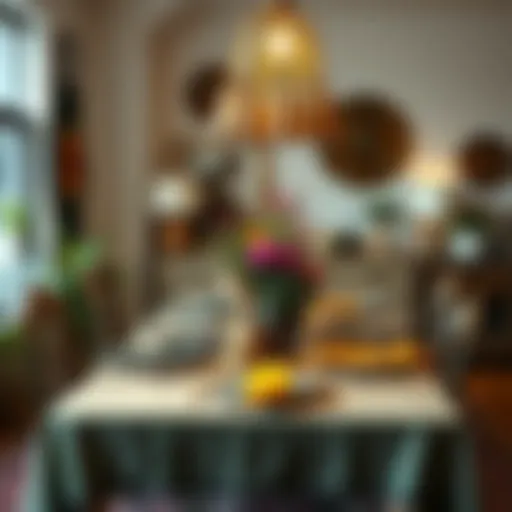Satin Bedspreads and Comforters: A Complete Guide
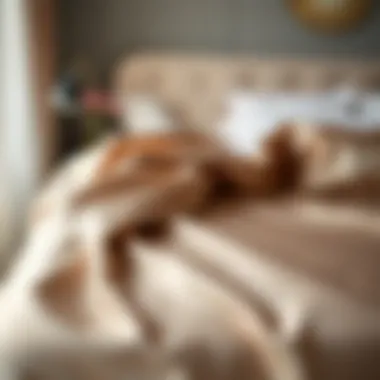
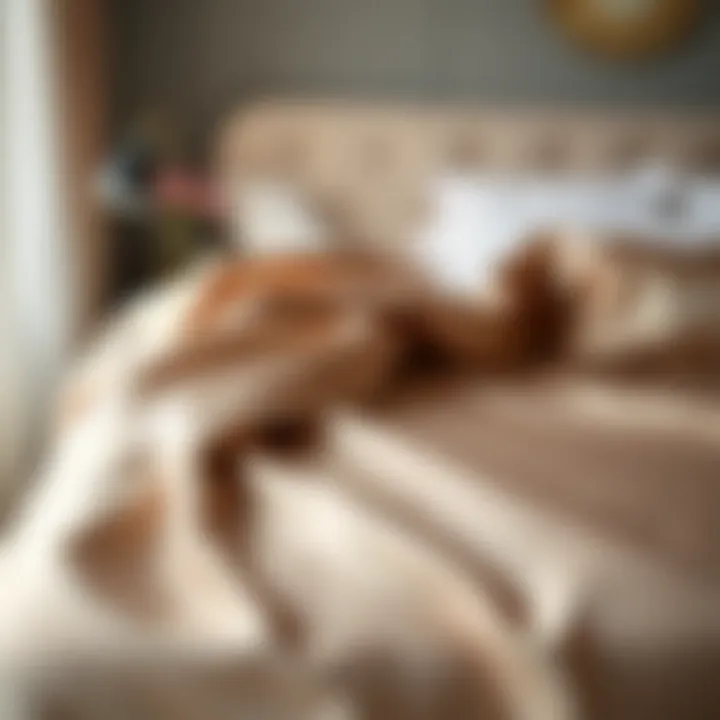
Intro
Satin bedspreads and comforters are often viewed as the epitome of elegance in bedroom decor. Renowned for their smooth and glossy finish, satin fabrics can elevate any room from ordinary to extraordinary. But, look beyond their surface beauty, and you will find a world of material properties, practical considerations, and stylistic choices that speak to both aesthetics and functionality.
This guide aims to unravel the complexities of satin bedding while shedding light on the latest design trends and practical buying tips. From understanding the nuances of the material to selecting the perfect piece that harmonizes with your home’s interior design, we will explore everything you need to know. Whether you are a homeowner eager to refresh your bedroom or a designer seeking the latest in fabric trends, there is something here for everyone.
In the following sections, we will delve into design trends, offering insights into current furniture styles and how to incorporate them seamlessly into your living spaces. Next, we will navigate the buying landscape, providing advice on choosing quality styles that ensure value for your investment.
With this guide, let’s take the plunge into the universe of satin bedspreads and comforters, appreciating not just their beauty but also their contributions to creating a warm and inviting bedroom ambience.
Understanding Bedding Materials
When embarking on a journey to make your bedroom as cozy and stylish as possible, understanding the materials used in bedding is crucial. This knowledge allows you to make informed decisions that align with your personal preferences and functional needs. Materials can affect everything from comfort and durability to maintenance and aesthetics. With a myriad of options available in the bedding market, being well-versed in those materials helps elevate your bedding choice from mundane to marvelous.
The Basics of Bedding Fabrics
Bedding fabrics come in a variety of types, each carrying its own unique features. The most common fabrics—cotton, linen, satin, and polyester—bring forth differing levels of softness, breathability, and warmth. Natural fabrics, like cotton and linen, tend to excel in breathability and comfort. Synthetic options, such as polyester, often rank high in durability yet can lack the natural feel many people seek. Understanding these differences helps you tailor your bedding to your comfort preferences.
What is Satin?
Satin is a weave, not a fiber. It can be made from silk, polyester, nylon, or other materials. The key defining feature of satin is its glossy surface, which is achieved through a weaving technique that allows for a higher thread count on one side, creating a smooth texture. This characteristic not only makes satin visually appealing but also gives it a luxurious feel, contributing to its popularity in bedding choices. Satin brings a level of elegance to any bedroom, transforming ordinary spaces into something a tad more luxurious.
Different Types of Satin
Polyester Satin
Polyester satin is one of the most widely used types due to its cost-effectiveness. This fabric is durable and resistant to wear and tear. It's known for its shiny surface and smooth touch, making it a favorable option for bedding. Why is polyester satin a go-to choice? It offers the luxurious look of satin without the hefty price tag that silk satin carries. However, it’s worth noting that polyester satin can lack the breathability that natural fabrics provide. This can sometimes lead to overheating, especially in warmer seasons.
Silk Satin
Silk satin, often considered the gold standard among satins, offers an unmatched luxurious feel and shine. What's the main attraction? The softness of silk combined with its natural hypoallergenic properties makes it ideal for sensitive skin. However, this luxury comes with a price; silk satin requires more delicate care, as it can easily be damaged by harsh detergents or hot water. Additionally, silk satin is more expensive than its polyester counterpart, making it a consideration for those looking to invest in high-quality bedding.
Nylon Satin
Nylon satin presents a unique alternative in the satin family. It is known for its stretch and resilience, which can be appealing for those who favor durability in their bedding. What sets nylon satin apart? It is less prone to wrinkling, which means it can maintain its sleek appearance over time. However, similar to polyester, nylon may not provide the breathability of silk satin. Thus, it might not be your best bet if comfort during hot nights is a concern.
In summary, selecting the right satin material for your bedspread or comforter comes down to balancing budget, aesthetic appeal, and individual comfort preferences. Each type of satin presents its own mix of advantages and drawbacks that can shape your overall sleep experience.
Satin Bedspreads: An Overview
Satin bedspreads are more than just a decorative cover for your bed; they play a significant role in enhancing the overall look of a bedroom. What you choose to drape over your bed often sets the tone for the entire space. Satin bedspreads can transform a mundane bedroom into a haven of elegance and comfort. With their smooth texture and shiny surface, they scream luxury while providing practical benefits that appeal to a diverse audience, including homeowners, designers, and DIY enthusiasts alike.
Defining Satin Bedspreads
A satin bedspread can be defined as a type of bedding which is typically made from satin fabric. Satin itself refers to a weaving style that creates a smooth, glossy surface on one side and a dull finish on the other. Choosing a satin bedspread does not simply come down to aesthetic appeal; the fabric is also known for its durability and easy maintenance. While it adds a touch of class to the bedroom, it also serves practical purposes, such as warmth during colder months and protection for underlying bedding.
Designs and Patterns
The design and patterns of satin bedspreads can influence the character of a room dramatically. Let’s delve into some prominent styles:
Solid Colors
Solid colors are classic, elegant, and incredibly versatile. They provide a clean and unified look, making them ideal for minimalistic designs or as foundational pieces in a more elaborate arrangement. One key characteristic of solid colors is their ability to mix well with various textures and other patterns without clashing. A solid satin bedspread can easily hold its own while still supporting additional decorative elements like patterned cushions or throws. However, one disadvantage is that they might not stand out as much in a variety-laden environment.
Floral Prints
Floral prints often bring a sense of warmth and liveliness to a bedroom. These designs can vary significantly, from bold, large blossoms to delicate, intricate patterns. The key characteristic of floral prints lies in their ability to add a touch of nature's beauty indoors. They are a popular choice, especially in casual or cottage-styled spaces. However, while floral designs can invigorate a room, they may clash with other elements if not carefully coordinated, potentially leading to a visually chaotic environment.
Geometric Patterns
Geometric patterns can lend a contemporary touch to any bedroom decor. These designs often feature bold lines and shapes that create an eye-catching focal point. The strengths of geometric patterns lie in their modern appeal and ability to complement various styles, from industrial chic to mid-century modern. However, the downside might be that they can become quickly dated or may overwhelm a room if paired with too many contrasting elements.
Aesthetic Benefits
Satin bedspreads provide a multitude of aesthetic benefits beyond just visual appeal. They contribute to an overall sensation of sophistication and tranquility in a bedroom. The reflective quality of satin can catch and play with light, creating an inviting glow that enhances the room's ambiance. Additionally, satin’s smooth texture enhances the tactile experience, encouraging relaxation and comfort. Thus, when you consider how a well-chosen satin bedspread can elevate a bedroom's atmosphere, it's clear why it is an essential element in home design.
Comforters: Understanding Their Role
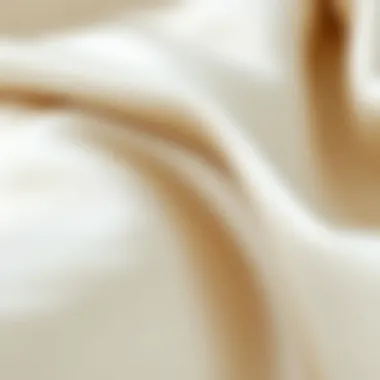
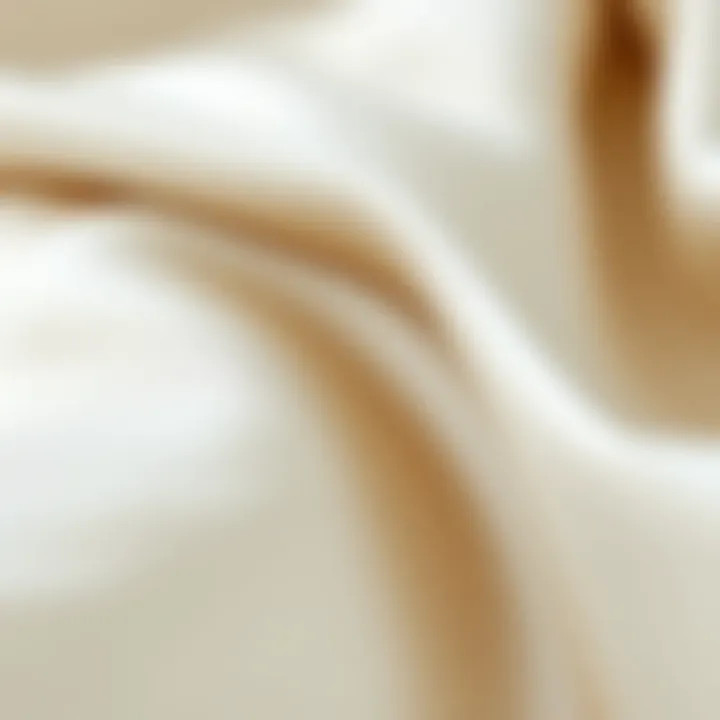
Comforters are often perceived merely as decorative elements on a bed, yet their true significance transcends aesthetics. They deliver warmth and comfort during cooler nights while playing a pivotal role in the overall feel of a bedroom environment. A well-chosen comforter can make your sleeping quarters feel snug and inviting, enhancing one's sleep quality significantly.
When considering the comforter for a bedroom, multiple factors come into play. These can range from material choice and construction techniques to the size that best fits the bed. The importance of understanding these elements cannot be overstated. The comforter serves as a foundational layer in bedding, making it key to both comfort and style.
Moreover, understanding the various types of comforters available in the market helps you make informed choices tailored to personal needs, room decor, and seasonal adjustments. In the following sections, we’ll explore what precisely defines a comforter and how they are constructed, giving you insights into proper selection and maintenance.
What is a Comforter?
A comforter is essentially a thick, quilted blanket filled with materials such as down, polyester, or cotton batting. It is designed to be placed on top of sheets, providing warmth and insulation while also contributing to the bedroom's visual appeal. Unlike duvet covers that require an insert, a comforter is often a stand-alone piece, making it simpler for quick bed-making and cleaner lines in decor.
The beauty of a comforter lies in its diverse range of styles and options. From modern minimalist designs to traditional patterns, the choices are almost limitless. Furthermore, they can vary in weight—lightweight options are perfect for summer, while heavier ones suit colder climates or seasons. This adaptability allows homeowners to curate their bedroom atmosphere according to their liking.
Construction of Comforters
The construction of comforters involves several elements that influence their functionality and appeal. Two crucial points within this domain are the fill material and stitching techniques. Understanding these factors can greatly enhance your selection process.
Fill Material
The fill material in a comforter determines how warm it will be. Commonly used fill options include down, synthetic fibers, or cotton.
- Down: This is made from the soft undercoating of ducks or geese. It’s incredibly warm and lightweight but can be pricier and may trigger allergies for some people.
- Synthetic Fibers: Polyester fill is a popular choice as it is hypoallergenic, affordable, and machine washable. It's an excellent option for those seeking easy care as well as durability.
- Cotton: Known for breathability, cotton fill provides a comfortable option, particularly in warmer climates or for those who sweat during sleep.
The key characteristic of each fill material lies in its insulation capacity. Down offers superior warmth, while cotton provides excellent temperature regulation. Each has unique advantages and disadvantages depending on personal preferences and needs.
Stitching Techniques
Stitching techniques are another crucial factor that influences comforter performance. The method of construction can determine how evenly the filling is distributed, which affects warmth and durability. Comforters can be stitched in a variety of patterns, such as baffle box or channel stitching.
- Baffle Box: This technique involves creating compartments using fabric walls, keeping the fill in place and preventing it from shifting, which enhances insulation and warmth.
- Channel Stitching: In this method, the comforter’s fill is enclosed in channels. This technique can create a flatter profile and is often lighter, which may be desirable in certain styles.
The choice of stitching greatly affects the visual appeal and longevity of the comforter. A well-stitched comforter tends to maintain its shape and filling better over time, making it a smart investment for your bedroom.
Choosing the Right Comforter Size
Selecting the right size comforter is essential for functionality and aesthetic balance. It’s crucial to match the comforter size not only to the mattress size but also to any additional bedding you may be using. For instance, a queen-size comforter typically needs to extend over the sides of a queen-size bed, providing complete coverage.
Here are some points to consider when choosing a comforter size:
- Bed Size: Match your comforter to your mattress size—twin, full, queen, king, etc. A larger comforter can provide extra drape and visual dimension.
- Drop Length: Consider how far down you want the comforter to hang over the sides. A longer drop can enhance the cozy look.
- Layering: Factor in mattress height or additional layers, such as mattress pads, to ensure your comforter fits well and doesn’t look short or ill-proportioned.
Ultimately, the right comforter can tie the room’s aesthetic together while ensuring comfortable sleep, striking an all-important balance between function and design.
Comparative Analysis: Bedspreads vs. Comforters
When it comes to bedding choices, whether you are decorating a cozy guestroom or a master suite, understanding the nuances between bedspreads and comforters can profoundly impact your selection. Both serve distinct purposes, yet they contribute to the overall comfort and aesthetic of your space. This section aims to dissect key aspects of these two bedding options, highlighting their advantages, disadvantages, and considerations that help homeowners and designers alike make well-informed decisions.
Advantages of Bedspreads
Bedspreads, often seen as the more decorative option, offer several benefits that appeal to many. One of the primary advantages is their versatility in design. Available in a myriad of patterns and colors, they serve as a canvas for personal expression in an individual’s bedroom.
- Lightweight Quality: Generally, bedspreads are lighter than comforters, making them easy to handle. This lightweight nature allows for a more breathable sleeping experience, ideal during warmer months.
- Elegant Cover: They create a polished look when made to fit over the entire bed. Often extending down to the floor, bedspreads give a more finished appearance, lending a sense of sophistication to the room.
- Easier to Maintain: With many beds, a simple daily fluff-up suffices, and regular washing handles stains and spills with relative ease. Many bedspreads are designed for machine washing, making them less labor-intensive compared to their bulkier counterparts.
In summary, bedspreads excel in terms of style, maintenance, and adaptability in various seasons, confirming their place as a favorite in bedroom decor.
Comforters: Pros and Cons
While comforters may not flaunt the same elaborate designs as bedspreads, they come with their own set of strengths and weaknesses worth considering.
Pros:
- Heat Retention: One of the primary advantages of comforters is their ability to provide warmth. The insulating properties of various fill materials, such as down or synthetic fibers, make them a go-to choice for colder climates.
- Variety in Fill Material: Whether you’re looking for the plush softness of down or the hypoallergenic benefits of synthetic options, you can find comforters accommodating different preferences.
- Layering Potential: Comforters can act as foundational pieces in a layered bedding approach, pairing well with quilts or throws for a cozier aesthetic.
Cons:
- Bulky Nature: Their greater thickness can make comforters cumbersome, occasionally making laundering a chore. They may require larger washers or specialty cleaning services, which adds to the overall cost of maintenance.
- Overheating Potential: In warmer climates or seasons, comforters may trap too much heat. This can lead to discomfort during sleep, making bedspreads a more favorable alternative for certain situations.
By weighing these pros and cons, one can better assess how well a comforter fits into their lifestyle and design goals.
Choosing Between the Two


Determining whether a bedspread or comforter is right for your needs involves more than just preference. Consider the following aspects:
- Climate: If you live in an area with distinct seasons, you might switch between both options, using comforters in winter and bedspreads in summer.
- Aesthetic Goals: The visual feel of your bedroom will guide your choice. For a richly layered look, comforters may be a standout choice. However, if minimalist elegance is desired, a chic bedspread could steal the show.
- Functional Needs: How much maintenance are you ready to handle? For simpler upkeep, bedspreads often come out on top, but cushiony comfort might tip the balance in favor of comforters for those who prioritize warmth.
Ultimately, both bedspreads and comforters have merits. It boils down to individual needs and lifestyle choices. As styles evolve, and personal preferences shift, understanding these subtleties ensures your bedroom remains a haven tailored to you.
Final Tip: Experimenting with both can lead to delightful combinations, enhancing your space in ways that echo both comfort and style.
By taking an analytical approach to this comparative analysis, readers will grasp the distinct advantages and challenges presented by both bedding types, ensuring a well-rounded understanding.
Care and Maintenance of Satin Bedding
Taking care of satin bedding is crucial for maintaining its beauty and longevity. Satin, renowned for its smooth texture and luxurious feel, requires a bit of attention to ensure it stands the test of time. Neglecting proper care can lead to a dull appearance, discoloration, or even damage that can ruin the elegant ambiance of your bedroom. This section dives into the essentials of caring for satin bedspreads and comforters, with practical tips that every homeowner or designer should consider.
Cleaning Satin Bedspreads
Cleaning satin bedspreads is not as daunting as it appears. The key lies in understanding the fabric's delicate nature. Here are some effective cleaning tips:
- Check the care label: Always start here; manufacturers often provide specific instructions for their products.
- Gentle washing: Either hand wash or use a machine on a delicate cycle with cold water. The detergent should be mild to avoid harsh effects on the fabric.
- Avoid bleach: It can eat away at the fibers, causing irreparable damage. Look for color-safe detergents instead.
- Drying process: Never wring out satin. Instead, lay it flat on a clean, dry towel to soak up excess water, then hang it to air dry. If using a dryer, select a low heat setting and remove it promptly to prevent wrinkles.
"A little care goes a long way. Treat your satin bedspread as you would a cherished item, and it will return the favor with lasting luster."
Maintaining Comforters
Comforters, while generally more robust than satin bedspreads, still need careful maintenance to retain their shape and warmth. Here’s what to keep in mind:
- Regular fluffing: Give your comforter a good fluff on a weekly basis. This helps distribute the filling evenly and maintain its loft, preventing it from becoming flat.
- Spot cleaning: For small stains, act quickly. Use a mixture of mild soap and water on a soft cloth, dabbing gently rather than rubbing.
- Periodic washing: Depending on usage, comforters can often withstand machine washing. Use cold water and a gentle cycle, and consider a commercial washer for oversized items.
- Drying tips: Similar to bedspreads, comforters should be air-dried or tumble dried on a low setting. Including dryer balls can help maintain fluffiness.
Storage Tips
When it comes to storage, satin bedding requires a bit of foresight to prevent any potential damage. Proper storage can extend the life of your satin beddings. Consider the following:
- Clean before storing: Ensure that bedspreads or comforters are clean and completely dry to prevent mildew and odors.
- Choose breathable bags: Avoid plastic. Instead, use cotton or fabric bags that allow air circulation while keeping dust at bay.
- Gentle folding: When storing, fold neatly rather than cramming, as wrinkles can set in over time.
- Control temperature: Store in a cool, dry place away from direct sunlight to avoid fading and heat damage.
By adhering to these guidance notes on cleaning, maintaining, and storing your satin bedding, you can enjoy its beauty and functionality for years to come. Proper care not only enhances the aesthetic appeal of your bedroom but also ensures that each piece remains a luxurious asset in your home decor.
Aesthetic Considerations in Bedroom Design
When designing a bedroom, the aesthetic elements play an important role in creating a space that is not only visually pleasing but also comfortable. The right choices in bedding can significantly impact the overall ambiance of the room. This section dives deep into aspects like color coordination, layering textures, and the incorporation of other textiles, all aimed at enhancing the elegance that satin bedspreads and comforters can bring.
Color Coordination
Choosing the right colors is pivotal in crafting a cohesive bedroom design. Color coordination involves ensuring that the shades of your satin bedding harmonize with the rest of the room’s decor. For instance, soft neutral tones such as beige or light gray provide a soothing backdrop, allowing the luxurious sheen of satin to stand out. Conversely, bold colors can energize a space. It's key to consider the mood you wish to evoke.
Tips for Effective Color Coordination:
- Complementary Colors: Use a color wheel to find shades that complement each other. If you opt for a deep blue satin comforter, consider light gray or white pillows and throws.
- Accent Colors: Consider incorporating a pop of color with cushions or art that aligns with a particular theme, enhancing the satin bedding’s appeal.
- Go Monochrome: If you’re feeling adventurous, a monochrome palette can create a sophisticated allure, where different shades of the same color are mixed.
Layering Textures
Layering textures can add depth and interest to a bedroom. Satin’s smooth finish pairs well with various materials, creating a visually rich environment. For example, juxtaposing satin with knits or quilts can break up monotony and provide comfort underfoot.
Practical Considerations when Layering:
- Balance is Key: Ensure that the layers complement one another to avoid clashing textures. A plush knit throw over a satin bedspread can work wonders.
- Visual Hierarchy: Place more prominent textures as foundational pieces (like bedding) and lighter textures (like decorative pillows) on top.
- Seasonal Switch-Up: Change your textures based on the season. Soft cotton or linen in summer can be just as cozy as satin in the cooler months.
Incorporating Other Textiles
Different textiles can work harmoniously to enhance the bedroom space. Elements like cushions, throws, and rugs not only add comfort but also support the overall design ethos.
Cushions
Cushions can be the cherry on top in a well-edited bedroom. They allow for experimentation with patterns and colors without overwhelming the space. The softness of cushions complements the smoothness of satin beautifully.
- Versatility: Cushions can be easily switched out with the seasons or trends, making them a flexible decor choice.
- Key Feature: Opt for cushions with diverse textures. A velvet finish on a cushion next to your satin bedding can create an attractive contrast.
- Consideration: While cushions serve aesthetic purposes, be mindful of the clutter. A couple of well-chosen cushions can make a statement without making a bed look frumpy.
Throws
Throws add warmth, but they also dramatically shift the room's atmosphere. They can be tossed over the back of a chair or laid casually across the foot of the bed.


- Characteristic Aspect: A chunky knit throw adds texture, while a lightweight satin throw can echo the sheen of your bedspread, tying the look together.
- Unique Feature: They work as an easy means to change up the room's color scheme. A simple swap out for a throw can transform the aesthetic instantly.
- Disadvantages: Ensure that the throws are functional, as overly decorative throws might not withstand regular use.
Rugs
Rugs serve both functional and aesthetic purposes in a bedroom. They define spaces and offer warmth underfoot. A good rug can ground the look of a satin bedspread and complete the room's decor.
- Contributing Element: Rugs can add dramatic flair. A patterned rug under a solid satin bedspread can create depth in your design.
- Highlighting Character: A soft area rug can encourage leisurely mornings, offering comfort as you step out of bed.
- Consideration: However, be careful with rug materials, as a high-pile rug might not be ideal if you like to keep your bedding deep clean.
In summary, paying careful attention to aesthetic considerations, such as color coordination and texture layering, can significantly enhance bedroom design, making it a personalized and inviting space. Incorporating other textiles like cushions, throws, and rugs can serve to unify the overall look while maintaining comfort.
Eco-Friendly Considerations
As we find ourselves amidst a growing urgency to make environmentally conscious choices, the discussion around bedding material choices, particularly satin bedspreads and comforters, cannot be overlooked. Eco-friendly considerations not only enlighten us about the materials we use but also stir a sense of responsibility for the planet’s well-being. Like the wavering tides, our choices in everyday items contribute to a larger consequence on the environment.
Sustainable Fabrics
When pondering over materials, the term "sustainable fabrics" often rises to the surface. These are textiles produced with meticulous attention to environmental impact, including factors like resource usage and toxicity levels. Sustainable fabrics are generally made from organic sources and utilize processes that minimize harm to the Earth, reducing pollution and waste.
Satin, while known for its luxurious sheen, can be created from more than just conventional materials. For instance, organic cotton satin emerges as a viable option, ushering in the soft touch of satin yet maintaining eco-friendliness. Let’s take a closer glance at some widely used sustainable fabrics:
- Tencel: Made from sustainably sourced wood, Tencel is known for its smooth feel and biodegradability.
- Organic Cotton: Grown without synthetic fertilizers or pesticides, organic cotton minimizes harmful runoff.
- Recycled Polyester: Made from recycled plastics, this fabric reduces waste while providing a similar texture to traditional polyester satin.
By choosing bedding made from these fabrics, individuals can enjoy the luxury of satin while being kinder to the environment.
Environmental Impact of Production
The environmental impact of production broadens the conversation beyond merely selecting a fabric. The entire lifecycle of satin bedspreads and comforters—from its creation to its eventual disposal—holds significance. Traditional satin production often involves the use of chemicals, which can present dangers to both workers and ecosystems alike. Production facilities, in turn, can contribute to air and water pollution, creating a ripple effect that harms wildlife and human communities.
Understanding the whole picture means recognizing the inherent dangers in non-eco-friendly production.
However, as the tide turns, numerous brands are now adopting more responsible practices:
- Water Conservation: Minimizing water consumption during dyeing and finishing processes.
- Chemical Management: Reducing or eliminating toxic chemicals in processing and production.
- Waste Management: Implementing recycling practices and utilizing leftover materials creatively.
Investing in eco-friendly bedding is akin to planting seeds for a healthy planet; it's about seeing beyond just a good night's sleep.
Popular Brands and Recommendations
When it comes to selecting the perfect satin bedspread or comforter, knowing the popular brands and receiving recommendations can save time and ensure quality. This section highlights some of the key brands that are making waves in the bedding market today. Choosing a well-established brand often means that you can expect durable materials, thoughtful design, and a certain level of customer service.
Top Brands for Satin Bedspreads
In the realm of satin bedspreads, a few names stand out due to their quality and design offerings. These brands have built their reputations on providing both style and comfort.
- Rage Mattress: Known for its luxurious satin finishes, Rage Mattress offers a range of bedspreads that not only look chic but also feel silky soft against the skin. They focus on hypoallergenic materials, which is a big plus for those with sensitive skin.
- Mellanni: A company that has gained attention for its affordable yet high-quality satin bedspreads. Mellanni’s products are machine-washable, making them a practical choice for busy households. They come in an array of colors to suit various design aesthetics.
- Martha Stewart Collection: This brand combines classic elegance with modern designs. The satin bedspreads from Martha Stewart are often colorful and feature intricate patterns, adding a touch of sophistication to any bedroom.
Highly Rated Comforter Brands
Just as with bedspreads, there are several brands that stand out in the comforter category, particularly those focusing on satin. They are known for their comfort and durability.
- Brooklinen: This brand has gained a following for its carefully crafted satin comforters that offer both warmth and breathability. The emphasis on natural materials helps ensure a good night's sleep.
- L.L. Bean: Renowned for its outdoor gear, this brand also excels in bedding. Their satin comforters are loved for their resilience and comfortable filling that can withstand the test of time, ideal for those who want longevity in their bedding.
- The Company Store: They offer a variety of satin comforters that come with rich colors and patterns. The quality of stitching and filling is top-notch, making them a worthwhile investment for a well-styled bedroom.
Remember: While researching brands, reading customer reviews can be incredibly helpful. Sometimes, a product may seem perfect, but actual user experiences bring out practical insights.
Finale: Making the Right Choice
When it comes to choosing the perfect bedding, satin bedspreads and comforters stand out as stylish yet practical options. The conclusion highlights the significance of making informed choices in your selection process, as your decision not only impacts your comfort but also shapes the overall ambiance of your bedroom. With various materials and styles available, it becomes essential to filter through the myriad of options to find what truly resonates with your personal taste and décor.
Personal Preferences and Styles
Selecting satin bedspreads or comforters begins with understanding your personal preferences and styles. What draws you in? Are you captivated by the glossy finish that satin provides, or are soft textures your priority? It can be helpful to consider how you want your bedroom to feel.
- Reflect on Your Aesthetic: Consider the existing color palette and the mood you wish to create. A striking red satin bedspread may enliven a neutral room, while pastel satin may evoke tranquility.
- Functional Needs: Are you someone who tends to get hot at night? Or do you prefer the warm embrace of a thick comforter? Understanding your nocturnal habits can guide you towards the right choice; perhaps a lighter satin bedspread for summer and a plush comforter for winter is the balance you need.
- Personal Touches: You might find value in unique patterns or custom designs. A satin bedspread in a geometric print can add interest, while floral patterns may pull a touch of nature into your space.
By tuning into what you cherish, you will be better equipped to make a selection that not only fits your style but also enhances your living space.
Balancing Functionality and Design
Design and functionality should walk hand in hand when selecting satin bedding options. It's vital to navigate these choices thoughtfully to create a harmonious environment in your bedroom. Let’s explore some key points:
- Durability vs. Aesthetic Appeal: Satin's luxurious look is inviting, but it is equally essential to assess its durability. Different types of satin have varying levels of resilience. For example, polyester satin may hold up better than silk under regular use.
- Ease of Care: Elegance shouldn't come at the cost of practicality. Consider how much effort you’re willing to put into maintaining your bedding. Some satin may require delicate washing, while others can manage a more routine cleaning.
- Purposeful Design: Ensure that the design contributes to the overall functionality of your bedding. For instance, a satin bedspread that’s merely decorative will not provide warmth or comfort. Conversely, a comforter should not only be visually attractive but also offer coziness and warmth when needed.
Finding a sweet spot between aesthetics and practical use will lead you to the right bedding choices.
Always remember, your living space is a reflection of who you are; choose bedding that speaks to your style while meeting your needs.















